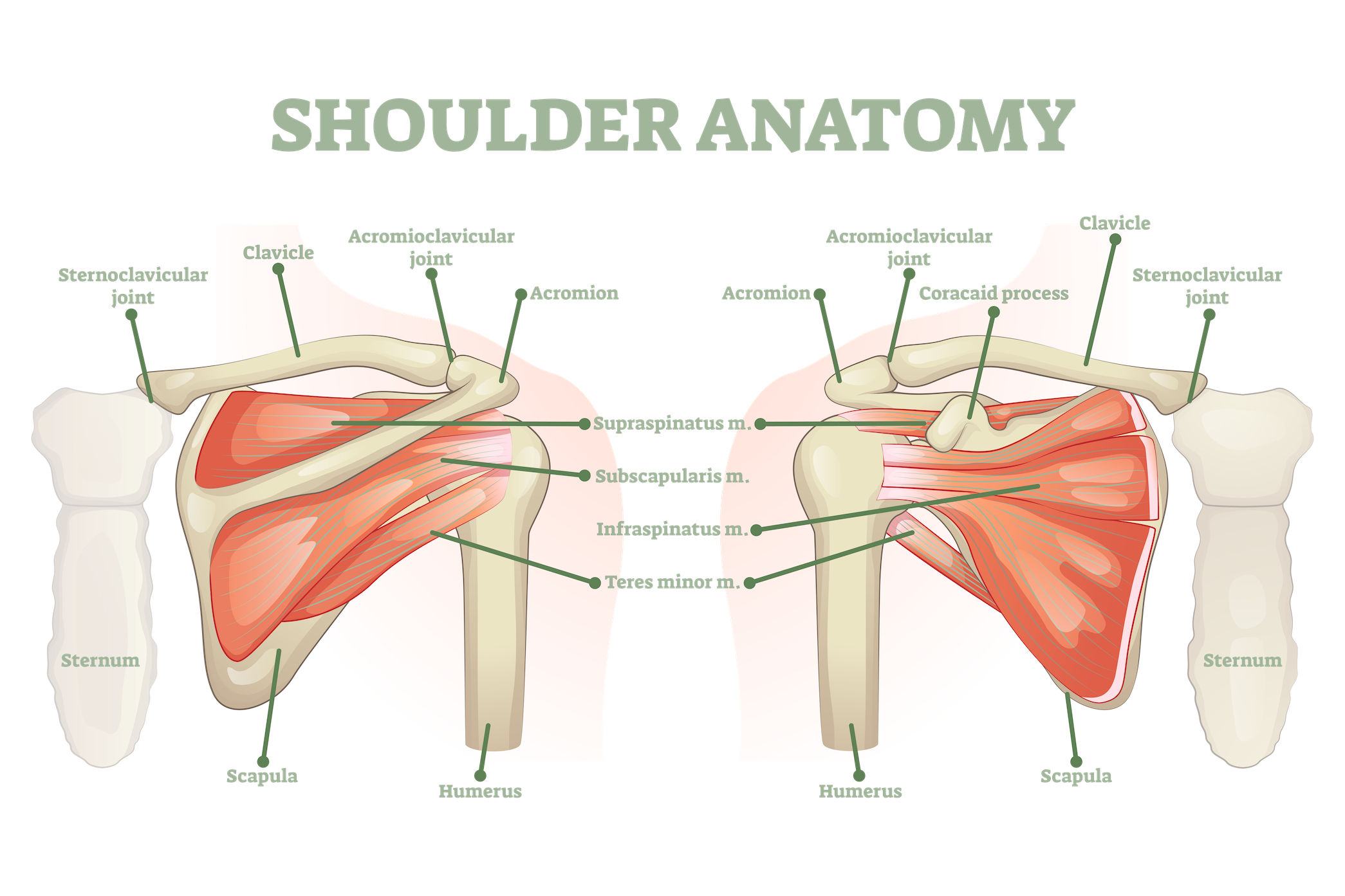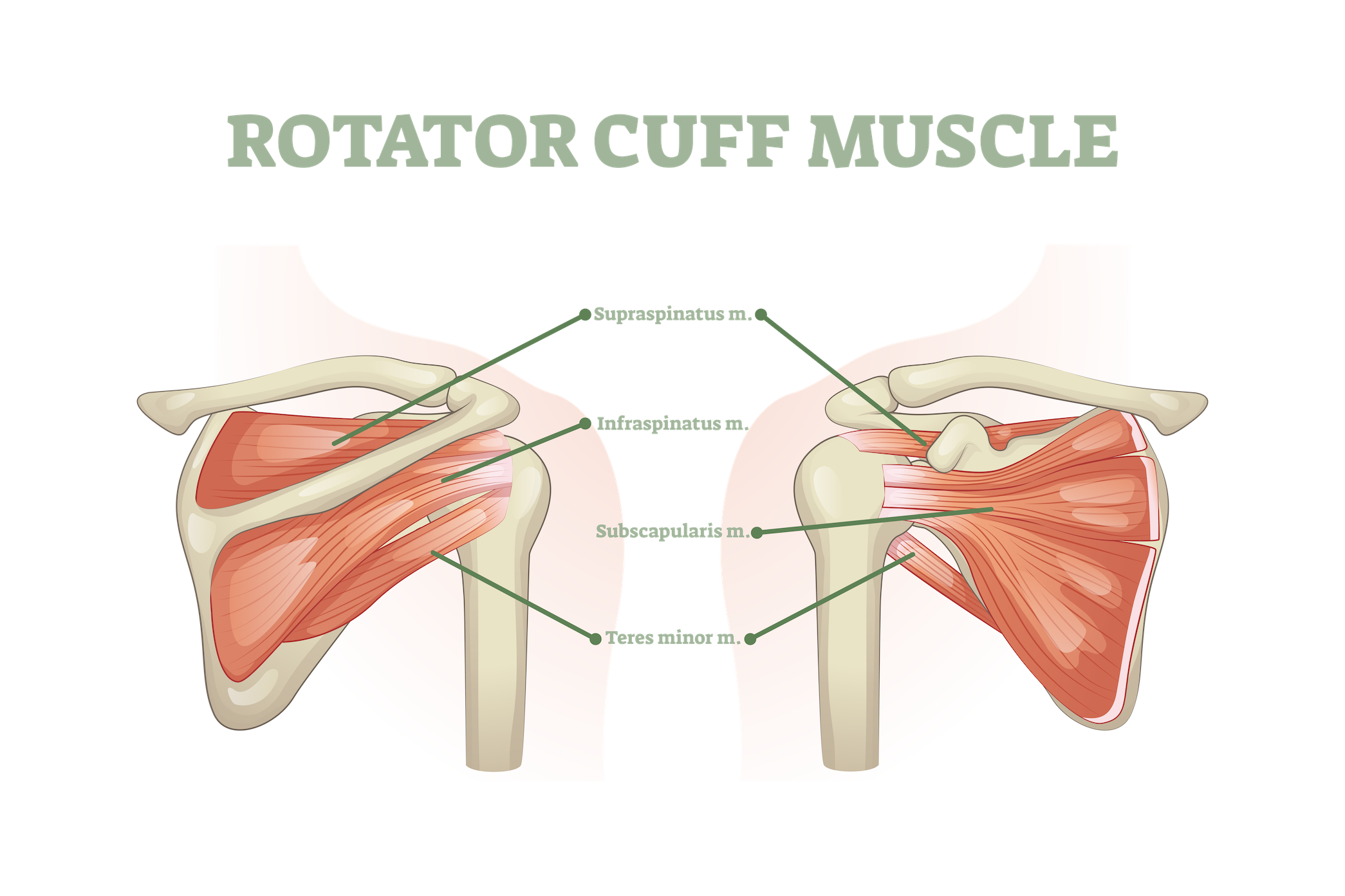Shoulder injuries from lifting are common but avoidable. Whether you’re dealing with post-workout pain or seeking preventative measures, this no-fluff guide covers the essentials—from recognizing symptoms to treatment strategies—helping you lift safely and recover effectively.
Key Takeaways
- The shoulder joint is a complex structure essential for various lifting tasks; maintaining strength and flexibility, especially in the rotator cuff, is critical for stability and preventing injuries.
- Symptoms of shoulder injuries include prolonged pain, loss of function, and physical deformities; these warrant immediate medical attention to prevent complications.
- Preventing shoulder injuries involves proper lifting techniques, warm-up exercises, regular shoulder-strengthening routines, and avoiding overloading through heavy or overhead lifting.
Understanding Shoulder Mechanics
The shoulder joint, also known as the glenohumeral joint, is a complex ball and socket joint that includes primary shoulder bones like the scapula, clavicle, and the upper arm bone, also known as the humerus. These bones are supported by tendons, ligaments, and the glenoid labrum, all contributing to enhanced stability.
This joint’s extensive range of motion allows for flexion, extension, abduction, adduction, and rotation, essential for various lifting tasks. However, this immense flexibility can also lead to instability and injury if not properly engaged during lifting.

The rotator cuff, comprising a network of muscles and their tendons, significantly contributes to the stabilization of the glenohumeral joint. Comprising four muscles – the supraspinatus, infraspinatus, teres minor, and subscapularis, the rotator cuff ensures the smooth functioning of the shoulder during lifting tasks. Another key player in shoulder mechanics is the deltoid muscle, which performs different shoulder movements such as abduction, flexion, and rotation of the humerus during lifting tasks.

The Role of the Rotator Cuff in Lifting
The rotator cuff is a group of muscles and rotator cuff tendon that hold the shoulder joint in place and facilitate arm and shoulder movement. During lifting activities, these muscles are responsible for ‘fine tuning’ the movements of the head of the humerus within the glenoid fossa, thus stabilizing the shoulder joint.
Balanced strength and flexibility in the rotator cuff muscles are vital for maintaining the functioning of the entire shoulder girdle. Hence, exercises that strengthen the rotator cuff are indispensable for activating the shoulder before lifting, notably at different degrees of shoulder abduction.
Exercises targeting the infraspinatus and teres minor are recommended as part of the shoulder warm-up routine to prepare the rotator cuff for lifting.
Shoulder Joint Complexities
The shoulder joint complex includes the sternoclavicular joint, acromioclavicular joint, and glenohumeral joint. These joints, along with connections between the scapula, clavicle, and humerus, contribute to the shoulder’s range of motion. The glenohumeral joint is the primary articulation between the humerus and the scapula, allowing a wide range of motion necessary for various lifting activities.
The shoulder complex consists of three main joints:
- The acromioclavicular joint, which allows for axial rotation and antero-posterior glides during lifting. It provides minimal structural support.
- The coracoclavicular joint, which is reinforced by its ligament and adds stability to the shoulder complex.
- The sternoclavicular joint, which is the only bony attachment of the upper limb to the axial skeleton. It plays a pivotal role in shoulder movement.
Recognizing Symptoms of Shoulder Injuries
Rotator cuff dysfunctions can manifest as shoulder pain and may result in impaired functional capacities and diminished quality of life. Some rotator cuff injuries might present as weakness or loss of shoulder function, even in the absence of pain. Observing these symptoms is vital as they could signal an underlying injury.
A dislocated shoulder, one of the two common shoulder injuries, is a frequent issue among gym-goers and athletes. It occurs when the ball at the top of the arm bone pops out of the socket. This can lead to:
- Visible deformation
- Extreme pain
- Inability to move the joint
- Swelling
- Bruising
- Numbness
- Weakness
- Tingling near the injury
- Possible muscle spasms
If you experience any of these symptoms, it is important to schedule an appointment with an orthopedic surgeon who specializes in shoulders.
When Discomfort Turns into Pain
While normal muscle fatigue from lifting typically resolves with rest, pain can persist and indicate an injury. Persistent discomfort after lifting, especially when it doesn’t resolve with standard recovery protocols, may signal the onset of an injury.
Pain that affects how lifting tasks are performed should be considered a warning sign and may represent an injury progressing. Keep in mind that working through continuous pain can worsen possible injuries and extend recovery time.
Red Flags: When to Seek Medical Attention
Recognizing when to consult an orthopedic surgeon for shoulder pain is paramount. Severe shoulder pain could indicate a serious condition such as a complete tissue rupture or severe bursitis and requires immediate medical attention.
Loss of smooth movement in the shoulder joint or difficulty moving the arm after two weeks is a sign that medical advice from a general practitioner or specialist should be sought.
A visible deformity in the shoulder, especially if it appears as a shoulder dislocation, should be considered a medical emergency and requires prompt medical intervention to prevent further complications.
Additionally, you want to make sure that you see an orthopedic surgeon who specializes in shoulders, preferably one who is fellowship-trained.
Common Causes of Lifting-Related Shoulder Injuries
Repetitive movements, especially those involving overhead activities, can lead to progressive wear and tear of tendon tissue, resulting in rotator cuff injuries. A rotator cuff injury can also occur due to improper lifting technique, which can lead to significant wear and tear to the shoulder complex, potentially causing strains, sprains, and even a rotator cuff tear.
Moreover, lifting weights that are excessively heavy for the individual can cause overuse injuries such as tendinitis, resulting from increased friction and inflammation in tendon sheaths. Grasping these common causes can aid in developing safer lifting habits and sidestepping such injuries.
Overhead Activities and the Risk to Your Rotator Cuff
Repetitive and rapid overhead movements can lead to a range of shoulder injuries, including:
- Bursitis
- Shoulder impingement
- Tendonitis
- Rotator cuff injuries
These injuries may affect your daily activities.
Shoulder impingement occurs when the tendons or nerves of the rotator cuff become pinched between the top of the upper arm and the tip of the shoulder, leading to pain and muscle weakness. Acknowledging these risks can guide modifications in your workout routines and lifting techniques to safeguard your rotator cuff.
Preventative Measures for Safe Lifting
Preventing shoulder injuries from lifting involves several measures. Avoid lifting heavy objects overhead; instead, keep them at or below waist level and close to the body, using your legs to lift and maintaining an upright posture to prevent shoulder injuries. Good posture aids in preventing shoulder injuries; standing up straight and sitting with proper back support can alleviate shoulder pain and protect against further injuries.
Moreover, engaging in exercises and movements that prevent injury can help maintain shoulder health. Some tips include:
- Employing proper technique when performing bench presses to minimize shoulder stress
- Choosing safer exercise alternatives to avoid impingement
- Taking breaks during repetitive activities
By following these tips, you can ensure the health and well-being of your shoulders.
Warm-Up Exercises to Protect Your Shoulders
Incorporating extensive shoulder warm-up activities such as foam rolling, stretching, and activation drills into regular exercise routines can help maintain shoulder health and prevent injuries related to lifting.
To prepare for lifting, it is recommended to include mobility drills like foam rolling the thoracic spine and lats, and stretching the pectoralis muscles. Each sequence should last 30-60 seconds, and involve dynamic movements for 3-5 repetitions.
Strengthening shoulder muscles through exercises can improve stability crucial for lifting. Some exercises to try include:
- Planks with shoulder raises
- T-Y-I movements
- Side plank roll
- Standing snow angels with bands
Employing a variety of grips during warm-up exercises and advancing to these exercises can help prevent over-straining and promote balanced shoulder strength.
Maintaining Healthy Shoulders with Regular Exercise
Maintaining overall physical fitness, which includes stretching, rotating the shoulder through its full range of motion, and strengthening the wrists, arms, neck, and back, supports shoulder health.
Regularly performing exercises like lat pull-downs with proper technique, which involves the trunk reclined at 30 degrees, strengthens the latissimus dorsi and scapular retractor muscles. Seated military press exercises build strength in the anterior, medial, and rear deltoid muscles as well as the upper back, which contributes to shoulder stability.
It’s recommended to perform shoulder exercises consistently 2 to 3 days a week for long-term shoulder health and injury prevention.
Treatment Options for Shoulder Injuries from Lifting
When shoulder injuries do occur, there are several treatment options available.
If rotator cuff problems are left untreated, they can result in complications such as permanent weakness in the shoulder joint or loss of motion. Pursuing early treatment is vital to avert these complications. Immediate weakness in the arm following an injury might necessitate quick medical advice as it indicates a serious injury, such as a torn rotator cuff, that could require surgery.
Surgery is considered the last resort treatment for shoulder injuries when all other interventions have not yielded successful outcomes.
First-Aid for Acute Shoulder Injuries
In the event of an acute shoulder injury, first-aid measures can be applied to alleviate pain and reduce inflammation. Applying ice or a bag of frozen vegetables to the injured shoulder area for 15 to 20 minutes several times a day can help reduce inflammation.
Using a cold pack is recommended for shoulder injuries accompanied by bruising, while a hot water bottle can be beneficial for gradual onset shoulder pain.
Rehabilitation and Physical Therapy
Rehabilitation and physical therapy are essential for recovering from shoulder injuries and restoring function. Physical therapy often provides relief for shoulder discomfort and is a key part of the rehabilitation process for shoulder injuries.
A comprehensive shoulder conditioning program includes a range of exercises designed to strengthen the muscles supporting the shoulder, restore range of motion, and prevent further injury.
Consistently monitoring for pain or discomfort is essential in the recovery process, as it allows for adjustments in the rehab regimen to avoid additional injury.
Living with a Shoulder Injury: Adaptation and Recovery
Living with a shoulder injury requires adaptation, recovery, and adjusting workout regimens to prevent further complications. To manage shoulder pain, use assistive devices for tasks such as dressing or reaching overhead. Modifying the home and work environment is necessary to reduce strain on the injured shoulder.
Pain management techniques such as ice, heat, and over-the-counter medications can help alleviate shoulder pain during recovery. Understanding the normal healing timeline for a shoulder injury can prevent frustration and uncertainty about pain levels. Workouts and job tasks should be adjusted; avoiding lifting heavy objects or repetitive overhead motions to prevent aggravating the injury.
Adjusting Your Workout Regimen
While dealing with a shoulder injury, it becomes essential to modify your workout regimen to prevent further harm and concentrate on exercises that foster recovery. Overhead pressing exercises like military press and shoulder press, as well as incline pressing exercises such as incline bench press, should be avoided to prevent exacerbating shoulder injuries.
Exercises that compress the shoulder, including planks, downward dog, and dip variations, should be avoided during the recovery from a shoulder injury. Shoulder Blade Squeeze is a beneficial exercise to help release tension and can be performed multiple times throughout the day.
Standing Wall Push-Ups can be engaged as a progressive exercise to strengthen the arms, shoulders, and chest safely without overloading a recovering shoulder.
The Journey Back to Full Strength
Regaining full strength encompasses mobilizing the shoulder joint, fortifying stabilizing muscles, and gradually enhancing strength while maintaining correct form. Recovery from mild shoulder injuries typically takes four to six weeks, but shoulder surgery recovery can extend from three to six months, demonstrating variability in the return to full strength.
The path to regaining strength after a shoulder injury begins with:
- Mobilization of the shoulder joint and muscles, particularly if the pectorals are tight and the upper back is weak.
- Strengthening the shoulder’s stabilizing muscles, including proper retraction of shoulder blades, is vital for effective shoulder muscle use during recovery.
- Once appropriate muscle activation is achieved, it’s recommended to progressively increase strength using volume and load, always maintaining good form to avoid further injuries.
Summary
To recap, understanding the shoulder’s mechanics, recognizing early signs of injury, adopting safe lifting practices, and engaging in appropriate treatments are key to preventing shoulder injuries from lifting.
The journey to maintaining healthy shoulders is a consistent commitment to shoulder care, but the payoff, which includes pain-free lifting and enhanced quality of life, is well worth the effort.
Frequently Asked Questions
What are 2 warning signs of a rotator cuff tear?
Two warning signs of a rotator cuff tear are shoulder pain and weakness. Seek medical attention if you experience these symptoms.
How do you heal a shoulder injury from lifting?
To heal a shoulder injury from lifting, it’s important to rest, apply ice, and take anti-inflammatory medications. After the pain has eased, physical therapy may be necessary to regain shoulder movement. It’s recommended to consult a healthcare provider for a personalized treatment plan.
What is the most common shoulder injury from weight lifting?
The most common shoulder injury from weight lifting is a rotator cuff injury, which is caused by straining or tearing the muscles that allow the shoulder to move.
How do you know if a shoulder injury is serious?
If you experience symptoms like inability to move your shoulder, feeling like it’s out of its socket, or visible joint deformity, it’s important to consult an orthopedic surgeon for evaluation and treatment.
What is causing shoulder pain?
Rotator cuff tendinitis or bursitis is the most common cause of shoulder pain, occurring when tendons become trapped under the bony area in the shoulder and become inflamed or damaged.






